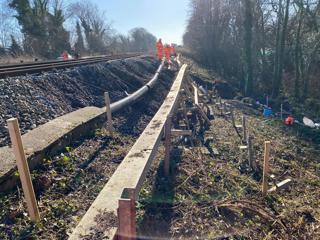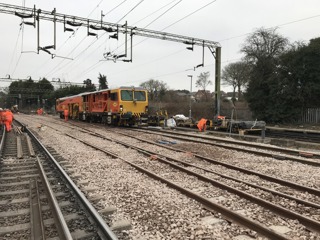Until very recently, Keith Williams and his long-awaited rail review qualified as a railway equivalent of the sasquatch or Loch Ness Monster – frequently discussed but never actually seen!
Williams was appointed by Secretary of State Chris Grayling in the chaotic meltdown triggered by the botched May 2018 timetable change. Publication was anticipated by year-end 2019, but that didn’t happen and then a virus we’d never heard of wreaked global havoc, rendering publication pointless.
Passenger traffic crashed by 95%, franchising died with the stroke of a DfT pen, and our railway faced far greater problems than the timetable humiliation which had prompted Williams’ review. It was inevitable - and the right thing - to delay and update it, to take account of the ghastly year of 2020.
Finally, we have the report, rebranded The Williams-Shapps Plan for Rail. Secretary of State for Transport Grant Shapps’ self-promotion is easily mocked, but it’s actually a good thing. Shapps doubtless attached his name during the last lap in order to lay claim to any success. Equally, he will have to own the failure if Government screws it up.
As always with reviews, some folk like the report, while others are highly critical (cue Wolmar, pages 46-47). Dispassionate assess-ment is made yet more difficult by generally poor media reporting and the filtering of political and trade union reactions through their chosen ideologies. The result? Heat, not light.
Cards on the table: it would be entirely disingenuous (hypocritical, even) if I took issue with the broad thrust of the Plan. And it is specifically thus entitled ‘Plan’ - not ‘Review’ or ‘Report’, which is significant. The Plan is an unequivocal statement of intent, albeit broadly expressed and with all the detail yet to be hammered out. But much of the Plan’s strategic aspiration aligns closely with what RAIL Comment pieces have urged since last July. Take a look - we’ve placed them on the RAIL website.
This document is about strategy. It is not intended to be a fully formed, detailed, tactical plan - yet much of the criticism I’ve seen has been rooted in tactical detail which will need to come later.
There are some aspects of this plan and its approach which ‘grind my gears’ - not least much of its underlying tone. There are plenty of aloof sideswipes at problems which are laid at the railway’s door. Trains with ‘ironing board seats’. Unworkable timetables. Season ticket price hikes. Just three examples (among many) which the report sniffily decrees that the railway must do better on, when the reality is that these problems and many more are a direct result of Department for Transport decisions and policy.
But let’s rise above that and examine those aspects of this plan which I do approve of. Career railwayman Sir Michael Holden, now a National Rail Awards judge as well as chairman of the Editorial Board of our business quarterly RailReview, is not only a committed rail supporter, he is also an often very sharp ‘critical friend’, and in a long thread on Twitter he captured how I largely feel about this Plan.
“I’ve now examined the entire White Paper,” said Michael. “My conclusion: it’s very much better than I had expected, although some bits are worked up in much more detail than others. It’s also heavy on aspiration and light on bankable mechanisms to achieve some of its objectives.”
So, let’s look beyond all that lazy, tedious journalism and punditry, making snide comments about the proposed Great British Railways name, the widespread readoption of the BR double arrow, or British Rail sandwiches. To see even Secretary of State Grant Shapps trivialise this watershed moment in the House of Commons, sniggering about curly sandwiches, merely damaged his credibility further. Irrelevant, too, given that characterising this Plan as a return to con-ventional nationalisation is to miss the point spectacularly. Because this Plan is entirely the reverse of traditional Nationalisation.
The biggest problem dogging the railway for the past decade (at least) has been increasingly stultifying DfT micro-management, under Treasury diktat, by doubtless well-meaning officials who are not railway specialists.
Civil service culture always seeks to avoid upsetting the Treasury by making decisions that would blight the next promotion, and this led to rampant risk aversion, paralysis and Olympian foot dragging.
The full extent and impact of this DfT-inflicted railway paralysis is not widely appreciated. I recently spoke to a highly experienced career railwayman at Avanti West Coast who was worn down by this: “At the last count, this operator alone is subject to daily oversight by 29 full-time civil servants. We cannot breathe, sneeze or leave the room without express DfT permission.”
Two years ago, at Rail Live 2019, a senior DfT official explained in exasperation that she had once been required to make decisions about coffee cup holders in new trains. This has to end. Ministers, officials and the Treasury don’t easily cede power, so full marks to the Williams team and those around them for seemingly succeeding in achieving agreement to this during the pandemic. I bet that’s been a long haul.
Thus, the welcome main thrust of The Williams-Shapps Plan for Rail is prying our railway from direct DfT micro-management.
Forget what you might think of the GBR name - the critical point is the decision to hand the railway back to a body of specialists who will manage it as the system which we all know it is. We must not become so immersed just yet in arguments about franchises, concessions, branding or train procurement (for example) that we lose sight of this fundamentally important point. We can argue details later - let’s establish and create that specialist body.
How did we get here? Turn the clock back to 2004, when Secretary of State Alistair Darling’s Rail Review abolished the Strategic Rail Authority and handed strategic rail policy directly to DfT officials. Asked for my view at the time, I told the SoS that blame had been nationalised: sooner or later, there would be a major problem which would default upwards until it landed on the SoS’s desk. With the removal of the SRA ‘buffer’, there would be nowhere else for it to go.
This finally happened in May 2018, triggering the chaos that led to Williams’ appointment. The timetable meltdown had finally laid bare the fatal flaw at the heart of the post-SRA construct: the separation of responsibility and accountability. Some may think these are the same thing. They are not.
This fatal flaw meant that from 2004, the rail industry was held accountable (blamed!) by the media, the public and even politicians. But the railway was in most cases not responsible for the controversial decisions which generated the most heat - it had to shoulder the blame for decisions it had not made and could not influence.
Civil servants, on the other hand, had made those decisions. But they were not held accountable. They kept quiet and let the railway take the heat. You cannot separate responsibility and accountability like this - but that is exactly what the 2004 Rail Review achieved.
The SoS was always vulnerable, as I concluded 17 years ago in 2004, and as May 2018 finally proved. There was no protective separation between the railway and the SoS.
London does this differently. The Mayor instructs the Transport Commissioner what sort of Tube and bus network is required, and what the budget is. Transport for London then either succeeds or fails, and the Commissioner either gets a pay rise or is sacked. That separation - the buffer - protects the Mayor.
The Prime Minister has first-hand experience of this political benefit, having worked for two terms as London Mayor with current Network Rail Chairman Sir Peter Hendy CBE as Transport Commissioner. Creating GBR both restores this political benefit and returns the railway to the specialist system management it so desperately needs.
Government must decide what sort of railway it wants, and its budget. A specialist GBR should then be left alone to deliver that railway. I cannot stress enough how important this is - and I make no apology for repeating my Vaccines Task Force analogy, because that is how GBR should be treated.
Government appointed a capable, highly respected VTF leader, Kate Bingham, who recruited a superb team of specialists. They were given a clear brief by the Prime Minister and - here’s the crucial bit - they were allowed to get on with their job without interference. And just look what happened: workable, effective vaccines delivered in less than a year, when we were told it could take a decade. Kate Bingham’s Vaccines Task Force burnished Government’s reputation.
Government must treat GBR as it treated Kate Bingham’s VTF. In Network Rail Chief Executive Andrew Haines, the railway has its own Kate Bingham, and the industry is packed with top-quality people to gather around him to do the same with railways.
The big risk is that Ministers, Treasury and DfT officials will either hobble GBR during its creation or be unable to resist meddling once it’s established. There are some worrying words in the Plan that seem to leave the door open for this. This absolutely must be resisted, and the best way to minimise this risk is for this Plan to be successful from this summer. I’ll come back to that. But it is going to require trust by those who would meddle, who need to keep their hands firmly in their pockets.
Andrew Haines, anointed in the Plan’s conclusion to play a leading role, will need a cool head and a measured approach.
He will need to keep Government focused on its own intentions, as clearly expressed by Williams-Shapps, to enable him to develop a 30-year rail industry plan.
He will need nerves of steel to resist pressure from media, politicians and the public for politically or financially expedient ‘short cut’ snake oil solutions.
Most of all, he will need deep reserves of patience, resilience and determination to handle what is likely to be one of the biggest challenges: workforce and working practice reform. The language already being deployed by the three main unions foretell stormy waters ahead. Government has avoided this for 20 years. You can bet that when GBR is set up, it will demand that this is an urgent priority!
The Plan makes very clear that emergency funding from the Treasury cannot continue indefinitely. In late May, we learned that in the past year, Chancellor Rishi Sunak had borrowed £300 billion to finance COVID strategy - ten times more than the £30bn expected.
There is no time to waste in getting to grips with what’s needed on the railway. But it will take at least two years to pass the required primary legislation in Parliament to establish GBR. Quite apart from the urgent need to restrict Treasury emergency funding, the Williams-Shapps’ conclusions (page 103) stress: “Swift delivery is essential to unlocking the important benefits, including customer benefits and cost efficiencies… the programme will accelerate change wherever possible….whilst we work through longer-term changes, the Government and sector will also bring forward benefits for passengers and freight customers quickly.”
Who will do this? DfT and Government have to work with what they have - there’s no time to hang around. It’s always been my firm belief that the only pragmatic solution is to reboot and reconfigure part of Network Rail to start work this summer and start that “swift delivery”. Nowhere is this explicitly confirmed in the Williams-Shapps Plan, but there are clues. It says: “Network Rail has successfully started this journey of change.....”
In the conclusion, the Plan goes on: “As a respected leader in the sector, Andrew Haines has been asked to develop plans for establishing interim arrangements drawing from across the industry and beyond, including RDG, the DfT and NR. This will be alongside his existing role as CEO of NR.”
This implies that DfT has instructed Haines to start work in areas which NR does not currently operate, and that some part of NR will indeed be rebooted and reconfigured as a home for that specialist team Haines will need. I cannot see any other way in which the Government can make real its promise of “swift delivery” to unlock benefits and (crucially) enable the Treasury to phase out that painful emergency funding as soon as possible
So, let’s not get too hung up on detail. I believe it’s crucial to focus now on the central thrust of this plan: to free the railway from inexpert DfT control and place it in the hands of a group of specialists who have a clear task and an equally clear budget. Then let them get on with it.
Yes, we will need procedures in place to ensure that GBR does not turn into a huge centralised bureaucracy, and this is why the Plan makes great play of devolution and new and bigger roles for a whole range of local and regional stakeholders
To his very great credit, Keith Williams has seemingly persuaded Government and Treasury to hand railway strategy back to those best equipped to manage it.
Tactics and detail discussions can follow soon - for now, let’s all do our bit to ensure that this most unexpected opportunity is firmly (and irrevocably) seized.

















Login to comment
Comments
No comments have been made yet.